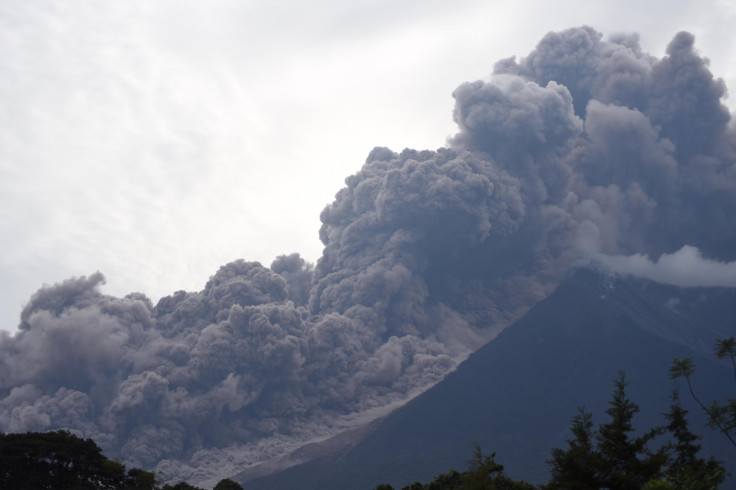Guatemala's Fuego Volcano Eruption Stops, 1.7 Million People Affected [Photos, Videos]

The Fuego (which in English means “fire”) volcano in Guatemala erupted for the second time this year Sunday, spewing a five-mile stream of lava, covering the neighboring areas in ash and causing thousands of residents to evacuate.
Around 6:45 p.m. local time ( 8:45 p.m. EDT) the National Institute for Seismology, Vulcanology, Meteorology and Hydrology of Guatemala (INSIVUMEH) confirmed the volcano had finally stopped erupting, tweeting the following report regarding volcanic activity:
Boletín Vulcanológico Especial No.33-2018, Domingo 03/06/2018. Finaliza erupción del volcán de Fuego. pic.twitter.com/mBgYrudpOC
— INSIVUMEH Guatemala (@insivumehgt) June 4, 2018
In the report, INSIVUMEH warned people that although “the rumbles and shockwaves have disappeared” and there was “abundant degasification,” volcanic ash covered 20 kilometers around the crater, with the possibility of the wind carrying it further into the land.
The Guatemalan government estimated that around 1.7 million people might have been affected by the volcanic eruption – the deadliest of its kind since 1974.
David de Leon, spokesman for the National Disaster Prevention Authority said “it was important to remain calm because the Fuego volcano erupts throughout the year,” adding that the change of wind was to be blamed for the volcanic ash falling on populated areas, the Guardian reported.
Videos of the volcanic eruption were posted on social media, which showed people fleeing from a dangerously thick plume of smoke billowing into the sky and a river of lava making its way down from the volcanic crater.
Today The Guatemala Fuego Volcano
— ∼Marietta (@ThisIsMarietta) June 4, 2018
Erupted. At Least Six Dead and Over 20 Injured.
La Aurora Airport In Guatemala Is Now Closed Due to Volcanic Ash. Flights to USA Have Now Being Cancelled.
Pray For All In Guatemala Today. 🙏#Fuego #Volcano #Guatemalapic.twitter.com/2V7Z8ToT1G
Witness to an eruption: Hiker's video captures eruption of Guatemala's Volcán de Fuego, which officials say is responsible for the deaths of at least seven people. https://t.co/ObLPKuRMxQ pic.twitter.com/aeoaJ54aNu
— ABC News (@ABC) June 4, 2018
Drone captures destruction caused by Fuego eruption in #Guatemala pic.twitter.com/Zbj27sb7OE
— Ruptly (@Ruptly) June 4, 2018
WTF... This is what people in #Guatemala 🇬🇹 saw after the Fuego volcano erupted less than an hour ago.
— Thomas van Linge (@ThomasVLinge) June 3, 2018
Deaths have already been reported. pic.twitter.com/9DbToOQl5z
Initially, Mario Cruz, the spokesman for the volunteer firefighter corps, said: “We have seven confirmed dead, four adults and three kids, who were already taken to the morgue.”
The disaster agency updated the death toll to 25 people, with more than 300 people injured. Both these numbers could increase as dozens of people are still missing. Around 3,100 people had to evacuate their houses.
The departments of Chimaltenango, Escuintla, and Sacatepéquez in Guatemala were the worst affected. After a meeting with his council of ministers, Guatemalan President Jimmy Morales declared a state of calamity in the three departments.
En reunión de Consejo de Ministros se decreta Estado de Calamidad Pública en los departamentos de Chimaltenango, Escuintla y Sacatepéquez ⚠️ pic.twitter.com/caJUnqCnBQ
— Gobierno Guatemala (@GuatemalaGob) June 4, 2018
Guatemala City, the capital of the country, which is 27 miles from the eruption spot, was moderately affected, with La Aurora international airport shutting down its singular runway.
A number of houses and its inhabitants were burned when the flow of lava changed direction and began flowing toward the village of El Rodeo, BBC reported. The Conred head Sergio Cabañas told a local radio station: “It's a river of lava that overflowed its banks and affected the El Rodeo village. There are injured, burned and dead people. Unfortunately El Rodeo was buried and we haven't been able to reach the La Libertad village because of the lava and maybe there are people that died there too."
The Guatemalan military tweeted saying they were helping in rescuing citizens affected by the volcanic activity by setting up temporary shelters around the country and assisting in the cleanup of the airport runway.
Elementos de la Primera Brigada de Policía Militar "Guardia de Honor", realizan limpieza en la pista de aterrizaje del Aeropuerto Internacional "La Aurora", afectada por la caída de ceniza volcánica.#365DíasAlServicioDeMiPatria pic.twitter.com/nnnd0ULA1u
— Ejército Guatemala (@Ejercito_GT) June 4, 2018
Due to the raining ash, health officials in Guatemala have warned citizens to wear masks when stepping out of their houses. The disaster agency also warned people to stay alert for the coming few days and stay away from lahars (violent type of mudflow or debris flow composed of a slurry of pyroclastic material, rocky debris and water) that might have formed due to overwhelmingly strong volcanic activity.
© Copyright IBTimes 2024. All rights reserved.





















